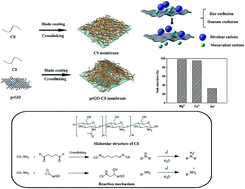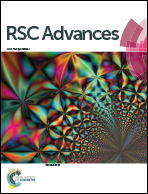Partially reduced graphene oxide and chitosan nanohybrid membranes for selective retention of divalent cations†
Abstract
A tremendous quantity of brackish water with a high proportion of divalent cations is in great need of water softening. Layer-stacked graphene oxide membranes show potential in membrane processing due to their molecular sieving properties, but show poor selective retention of cations due to unstable interlayer spacing and electrostatic interaction. In this study, a partially reduced graphene oxide (prGO) and chitosan (CS) nanohybrid membrane (prGO–CS) was fabricated to achieve the selective retention of divalent cations by adjusting the configuration and controlling the surface charge. The prGO–CS membrane, which included a CS skin and embedded prGO sheets, showed a performance boost of 98.0% rejection of Mg2+ and 95.5% rejection of Ca2+ when compared with a CS membrane. The membrane showed good water softening performance for brackish water under low operation pressure with a high Na+/Mg2+ selectivity of 33.8. The excellent performance was attributed to the dense structure and positive charge of prGO–CS.



 Please wait while we load your content...
Please wait while we load your content...